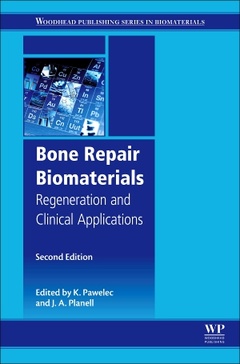Bone Repair Biomaterials (2nd Ed.) Regeneration and Clinical Applications Woodhead Publishing Series in Biomaterials Series
Coordonnateurs : Pawelec Kendell, Planell J. A.

Bone Repair Biomaterials: Regeneration and Clinical Applications, Second Edition, provides comprehensive reviews on materials science, engineering principles and recent advances. Sections review the fundamentals of bone repair and regeneration, discuss the science and properties of biomaterials used for bone repair, including metals, ceramics, polymers and composites, and discuss clinical applications and considerations, with chapters on such topics as orthopedic surgery, tissue engineering, implant retrieval, and ethics of bone repair biomaterials. This second edition includes more chapters on relevant biomaterials and a greatly expanded section on clinical applications, including bone repair applications in dental surgery, spinal surgery, and maxilo-facial and skull surgery.
In addition, the book features coverage of long-term performance and failure of orthopedic devices. It will be an invaluable resource for researchers, scientists and clinicians concerned with the repair and restoration of bone.
Part 1: Bone Repair Biomaterials 1. Challenges of bone repair 2. Bone anatomy, physiology and adaptation to mechanical loading 3. Bone repair and regeneration 4. Biomechanical aspects of bone repair
Part 2: Biomaterials 5. Properties and characterisation of bone repair materials 6. Metals as bone repair materials
Part 3: Surface coating of titanium 7. Ceramics as bone repair materials 8. Polymers for bone repair 9. Composite biomaterials for bone repair 10. Cements as bone repair materials 11. Bioactive polymer coatings to improve bone repair
Part 4: Clinical Applications 12. Using bone repair materials in orthopaedic surgery 13. Using bone repair materials in dental surgery 14. Using bone repair materials in spinal surgery 15. Using bone repair materials in maxilo-facial and skull surgery 16. Bone tissue engineering
Part 5: Advanced manufacturing/3D printing? 17. Long-term performance and failure of orthopaedic devices 18. Retrieval and analysis of orthopaedic implants 19. Ethical issues in bone repair and bone tissue engineering
Biomaterials scientists, biomedical researchers and orthopaedic clinicians concerned with bone repair, researchers and students in pharmaceutical science
Professor Josep A. Planell is highly regarded for his biomedical research at Universitat Politècnica de Catalunya, Spain.
- Provides a comprehensive review of the materials science, engineering principles and recent advances in this important area
- Presents new chapters on Surface coating of titanium, using bone repair materials in dental, spinal and maxilo-facial and skull surgery, and advanced manufacturing/3D printing
- Reviews the fundamentals of bone repair and regeneration, addressing social, economic and clinical challenges
- Examines the properties of biomaterials used for bone repair, with specific chapters assessing metals, ceramics, polymers and composites
Date de parution : 12-2018
Ouvrage de 440 p.
15x22.8 cm
Thèmes de Bone Repair Biomaterials :
Mots-clés :
Almost bioinert ceramics; Arthroplasty of the spine; Aseptic; Bacteria; Bioactive; Bioceramics; Biodegradable alloys; Biodegradable polymers; Bioinert; Biological barriers; Biomaterial; Biomaterials; Biomechanics; Biomimetic mineralization; Bioprinting; Bone adaptation to loading and unloading; Bone atrophy; Bone cements; Bone morphology; Bone regeneration; Bone remodeling and modeling; Bone repair; Bone replacement; Bone structure; Bone tissue engineering; Bone; Bone-anchored implant; Calcium phosphates; Cell encapsulation; Cell signaling in bone; Cements; Clinical relevance; Co-based alloys; Collagen; Composites; Conflict of interest; Corrosion behavior; Corrosion; Cross-linking; Degradable and bioactive ceramics; Degradable; Degradation; Dental restoration; Epidemiology; Ethics; Ex vivo analysis; Failure; Fiber; Glass-ceramics; Growth factor; Healthcare; Histology; Hydroxyapatite; Implant failure; Informed consent; Inorganic and organic bone matrix; Joint replacement; Leucite; lithium disilicate; Loosening; Magnetic metallic materials; Material characterization; Material properties; Mechanical properties; Metallic scaffolds; Microbiology; MicroRNA; Microstructure; Nanoparticles; Natural polymer; Ni-free alloys; Nondegradable; Non-viral delivery; Nucleic acids; Orthopedics; Osseointegration; Osteoconductive materials; Osteoinductive materials; Osteosynthesis; Particulate; Periprosthetic joint infection; Personalized regenerative medicine; Physiological effects; PMMA; Polymers; Polymethyl methacrylate; Prostheses; RALA peptide; Remodeling; Repair; Rhenanite; Scaffold; Septic; Shape memory alloys; Socioeconomic; Spinal anatomy; Spinal implant; Spinal tumors; Stainless steels; Stem cells; Surface; Surgery; Synthetic bone substitute materials; Third-generation bioceramics; Ti-base alloys; Traumatology; Trends in metallic biomaterials; UHMWPE; Wear; Xenogeneic bone substitute materials



